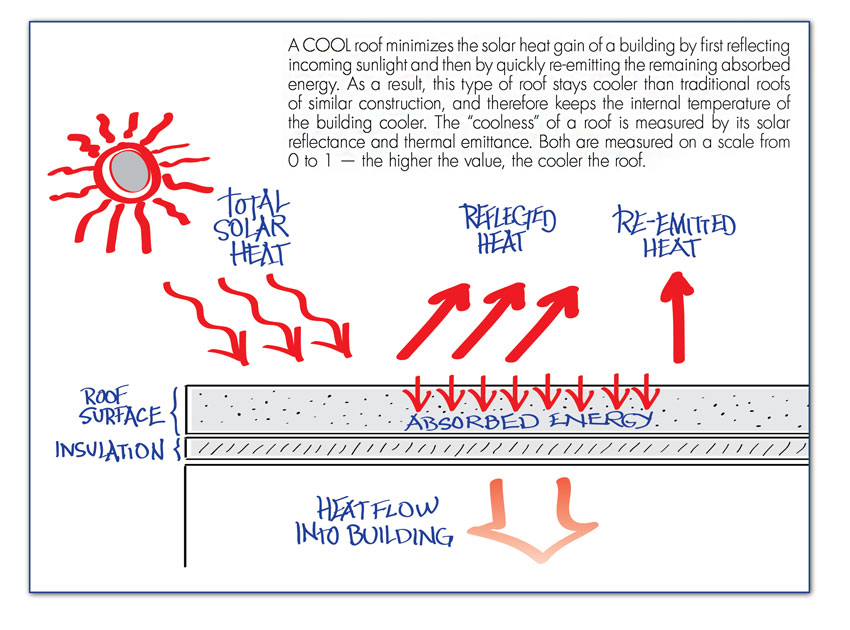Cool Roofing for Cool Climates
Cool Roofing in Northern Climates
Although cool roofing’s ability to mitigate the UHI is well established in warmer climates, can they be effective in northern regions?
“Yes, they can,” affirms Brett Polhill, territory sales and service manager, NIR Roof Care, Rockford, Illinois. “While the cooling savings would not be as high as in southern climates, the cooling energy savings outweigh the heating energy savings.”

Image courtesy of GAF
Cool roofs are not relegated to only southern climates. As pictured here, this U.S. Bank building in Boise, Idaho, is actively saving HVAC costs and helping to mitigate the urban heat island effect.
“While this impact will be more significant in warmer climates, there is an impact in northern climates,” agrees Dr. Trevor Nace, who holds a PhD. From Duke University in geology and climate, and is a contributing author to Forbes covering geology, earth science, and natural disasters.
That said, many building owners have the impression that dark roofing can help heat buildings in the winter.
Addressing this issue, Thomas J. Taylor, executive director building and roofing science, GAF Materials, Parsippany, New Jersey, points out a number of things. Firstly, during the winter, the angle of the sun is relatively low, so heat absorption isn’t very significant. Furthermore, the winter days are more frequently cloudy and snowy, further inhibiting the effectiveness of heat absorption on the rooftop.
Another important point is the fact that in all parts of North America, there are much fewer hours of daylight during the winter months. In fact, in some areas, there is a greater than a 6-hour difference between peak-summer and peak-winter sunlight. The upshot is there is far less sunlight available to contribute to a building’s potential warming.
Emphasizing this point, Stanley P. Graveline, technical committee member, Vinyl Roofing Division of the Chemical Fabrics and Film Association, explains that in northern states, winter solar irradiance is typically 20 to 35 percent of the summer irradiance. This means that a roof surface receives three to five times more sun during the summer than during the winter months.
To the extent that dark roofs help to reduce heating costs in the winter, the cooling energy costs during the summer for a TPO/PVC roof will offset the loss in heating savings of a dark membrane roof, explains Polhill.

Image courtesy of GAF
By rejecting heat as opposed to absorbing it, cool roofs keep buildings cooler in the summer, thereby reducing air-conditioning costs.
Addressing this issue, University of Wisconsin-Madison’s College of Engineering’s HVAC&R Center studied simulated “big box” black- and white-roofed retail buildings in Denver and Minneapolis.
“Their analysis demonstrates that even in such northern cities, cooling energy savings can be sufficient to compensate for any heating energy penalties that may be incurred through using cool roof surfaces,” concludes Graveline in a National Roofing Contractors Association (NRCA) Professional Roofing article titled “Still cool after all these years.”7
In a nutshell, the energy required to air-condition a building in the summer is often quite a bit more than the energy required to heat it in the winter, effectively correcting the misperception that if heating degree days outnumber cooling degree days, dark roofing should be specified. In fact, on average, it’s four times more expensive to cool in the summer with electricity vs. heating a building in the winter with gas. This means that the potential for summer energy cost savings are much greater with a highly reflective white roof than the winter savings offered by a heat-absorbing black roof.
Bringing up an important point, David Defilippo, AIA, architect, Tsoi Kobus Design, Boston, says, “You don’t heat a building by warming the roof—at least not yet.”
Another issue, as noted by the White Roof Project, is the fact that the laws of physics dictate that hot air will always rise, so any heat that is transferred to the interior of a building structure from the outside will remain at the top of the structure, thereby minimizing heat savings.
On Target
On the topic of cool roofing in northern climates, Target Corporation, which almost exclusively utilizes white PVC membranes on its stores, studied the energy savings delivered by its cool roofs.8
Based on the results of Target’s research, Graveline, one of the study’s authors, states in the Roofing Contractor article, “Target has experienced net-energy savings from the use of cool roofs in all but the most extreme climates. Although the savings in northern states are clearly less than those achieved in southern locations, experience over approximately two decades has validated the ongoing use of cool roofs across the entire real-estate portfolio. Even in climates with lengthy heating seasons, overall cooling costs exceed heating costs in Target’s facilities.”
He added that for Target’s few dark roofs, the company has not seen any measurable reduction of energy consumption during heating seasons that can be attributed to heat gain via the roof in northern climates.
In terms of the reduction of cooling expenses during the summer months, Taylor emphasizes that the days in northern cities are longer as opposed to southern climates, and the sun is high in the sky. So if the roof is not reflective, this can increase the load on air-conditioning systems.
That said, it is true that rooftop temperature reductions and subsequent cooling energy savings are more pronounced in southern climates. This is clearly highlighted in most roofing energy modeling programs, whereas the economic case for northern climate light-colored roofing is often understated because the calculation tool fails to take into consideration utility demand charges.
With typical utility pricing structures charging commercial end users based upon both overall monthly electricity use and the maximum demand level during that month, this forces building owners to look at these loads much more critically.
“Utility companies have to worry about two things when supplying a region: how much power they have to supply each month or quarter, and how to manage maximum demands that can occur when things like air-conditioning loads are at their highest,” Taylor explains. “They focus on the high demands that occur in a short period of time and will penalize a building owner for them.”
To differentiate between peak charges and demand charges, the former is when a utility charges a higher dollar per kilowatt hour rate (kWHr) structure at peak times, for example, between 1 and 6 p.m. during the summer months. This peak charge will apply equally to all end users.
In addition, demand charges are based on the highest 15 minutes of electric use by an end user. This charge is calculated as dollars per kilowatt of demand—i.e., the fastest speed that their electric meter runs in one month, even if for only 15 minutes. In an extreme case, the user might only turn on their AC once for 15 minutes in July, but they will get hit with a very large demand charge because the unit required a huge amount of power for that time.
As an example case provided by the U.S. Department of Energy, if one end user utilizes a 5 kW load spread out over 500 hours at rate of $0.15, a demand charge of $28 will only be applied to the 5 kW. This will result in a $515 utility bill. On the other hand, a 50 kW condensed into 50 hours uses the same amount of electricity but significantly condenses the load profile, forcing the end user to pay a much higher rate for drawing such a large load at peak times. The result, in this case, is a $1,775 bill, more than three times as expensive as the first scenario.

Image courtesy of the U.S. Department of Energy
A 5 kW load spread out over 500 hours result in a $515 utility bill, whereas a 50 kW condensed into 50 hours uses the same amount of electricity but produces a $1,775 bill from demand charges.
“Commercial peak rates are typically higher during midday, so it is in the electrical customer’s best interest to trim their peak demand usage and/or shift the usage to off-peak hours,” recommends Shad L. Traylor, AIA, NCARB, CDT, MBA, LEED AP BD+C, senior architect, BRPH, Melbourne, Florida.
It follows that if a light-colored roof can effectively reduce the electric demand in peak periods, this will improve the economics of a cool roof, says Gary P. Moshier, AIA, LEED AP BD+C, CPHD, partner, Moshier Studio, Pittsburgh.
Overall, as energy consumption continues to increase, more utilities will charge premium rates during peak demand times as a mechanism to motivate building owners to flatten out their load profiles.
In fact, the United Nations Intergovernmental Panel on Climate Change predicts that in most North American cities, a once-in-20-years hottest temperature event will start occurring every two years. Furthermore, that hottest temperature event will increase by 3.5 to 9 degrees Fahrenheit.
As an aside, to assist specifiers with computing demand charges, the Cool Roof Energy Savings Tool can be a helpful way to determine just how much energy savings a cool roof can deliver.9









